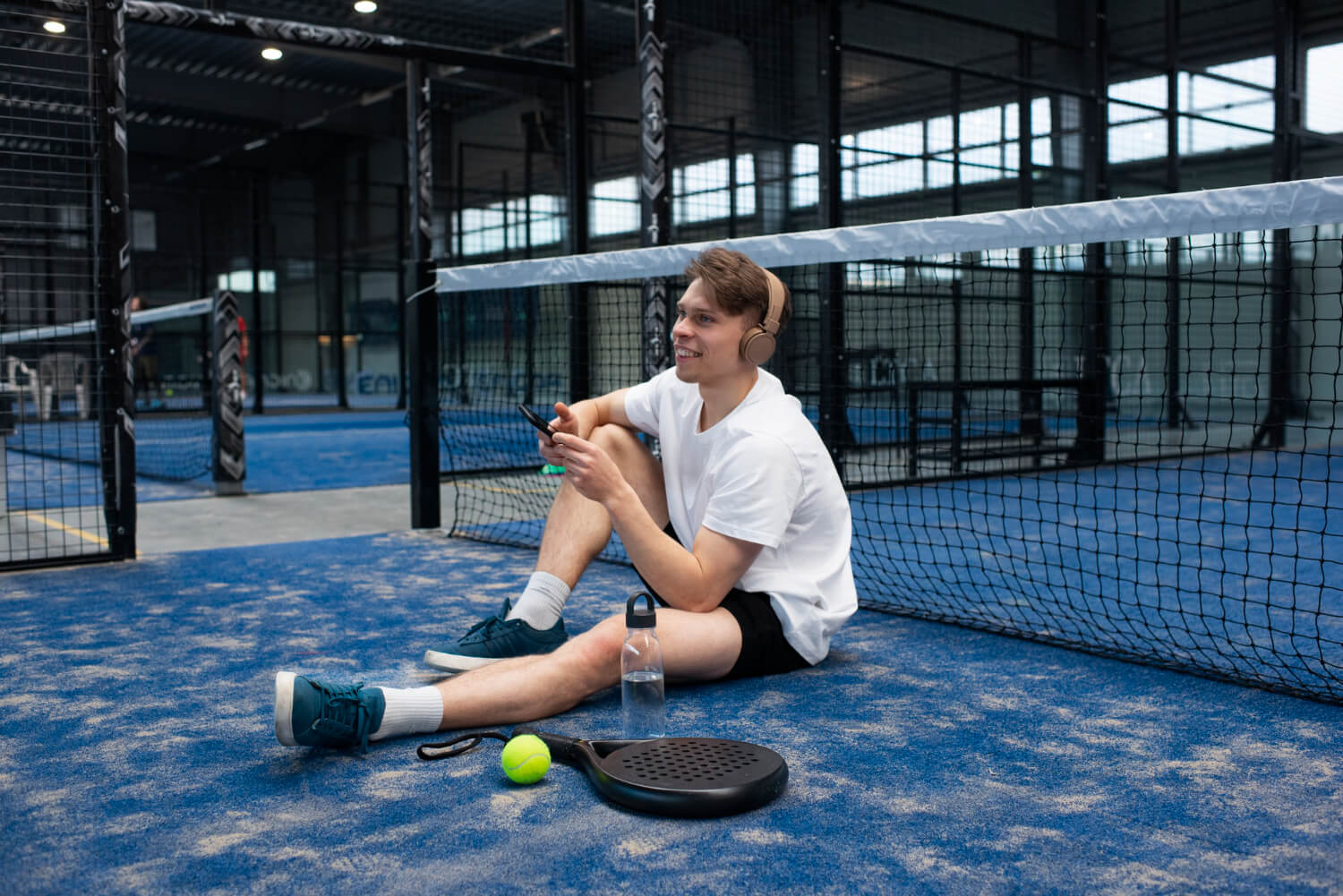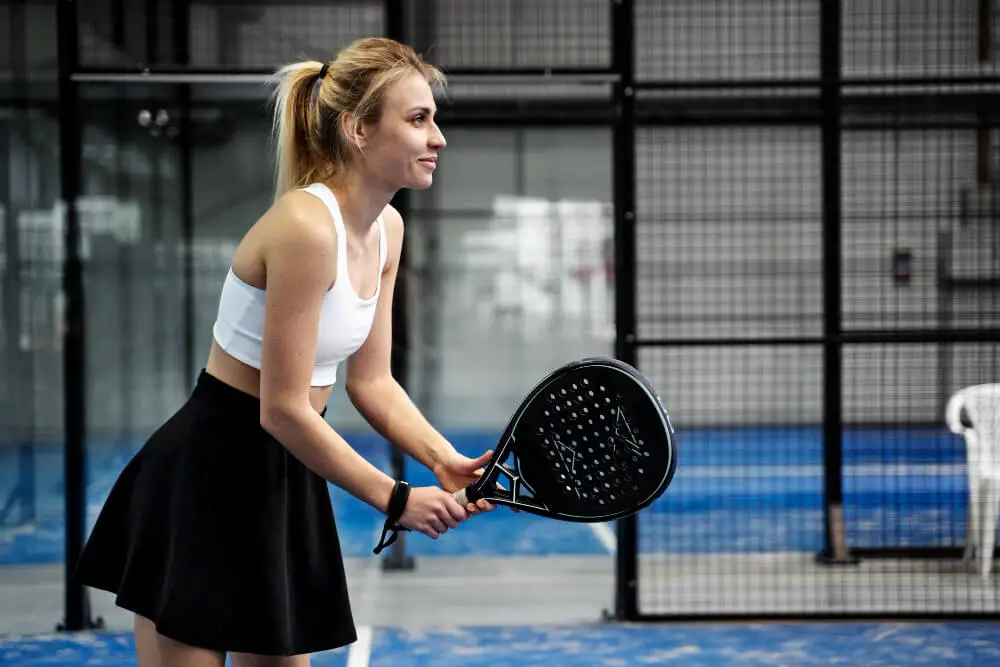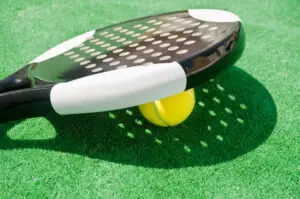Playing Padel tennis has many benefits for physical and mental health. It is a low-impact sport that can help improve coordination and balance. Additionally, it is a great way to socialize and relieve stress. Playing Padel can also help prevent injuries by strengthening muscles and joints.
What are the health benefits of padel tennis?
- Padel tennis is a great full-body workout that strengthens your arms, legs, and core.
- It improves coordination, balance, and agility.
- Playing padel can help reduce stress levels and improve well-being.
- It allows you to stay active during the pandemic in either an outdoor or spacious indoor environment.
Padel tennis is a rapidly growing racquet sport that blends elements of traditional tennis with squash and badminton. This fairly new addition to the world of racket sports boasts incredible health benefits, such as improved aerobic capacity, increased balance and agility, core and upper body strengthening, improved coordination, enhanced hand-eye coordination, and stress relief.
Research has also demonstrated that padel tennis can contribute to weight loss by burning calories while having fun. The great thing about padel tennis is that it is low impact and accommodating to players of all skill levels – which makes it an ideal activity for those looking to improve their exercise performance without putting too much strain on their bodies. All in all, playing Padel offers a challenging yet enjoyable workout that manages to squeeze in plenty of physical activity into little time!
Is Padel a High-impact Sport?
Padel is generally considered a lower-impact sport compared to activities like running or high-impact aerobics. The nature of the game involves lateral movements, quick changes of direction, and hitting the ball, but it typically doesn’t involve the repetitive pounding on joints that is often associated with high-impact sports.
However, it’s important to note that the impact level can vary depending on factors such as your playing style, the intensity of the game, your fitness level, and the condition of the court. While padel is generally gentler on joints compared to high-impact activities, it still involves some degree of impact, particularly on the lower body, due to the quick movements and sudden stops.
If you’re concerned about the impact on your joints, you can take certain precautions:
- Proper Footwear: Wear appropriate footwear (Padel Shoes) with good cushioning and support to help absorb some of the impacts and provide stability during lateral movements.
- Warm-up and Stretching: Prior to playing, engage in a proper warm-up routine and include dynamic stretches to prepare your muscles and joints for movement.
- Gradual Progression: If you’re new to padel or any sport, start gradually and allow your body time to adapt to the movements and demands of the game.
- Listen to Your Body: Pay attention to your body’s signals. If you experience pain or discomfort, it’s important to stop and rest to avoid potential injuries.
- Cross-training: Consider incorporating other low-impact activities like swimming or cycling into your fitness routine to give your joints a break while staying active.
Why Should You Play Padel?
Playing padel offers a multitude of compelling reasons to get involved in this dynamic sport. Beyond the exhilarating gameplay, padel brings an array of benefits that cater to various aspects of well-being. The social dimension of the game fosters interaction, making it an excellent activity to enjoy with friends and family or even make new connections. Regardless of age or fitness level, padel accommodates everyone, providing a platform for beginners and experienced players to engage in a thrilling experience. There are even padel teams for kids interested in padel, making it an inclusive and family-friendly sport.
The sport’s unique blend of cardiovascular exercise and strength training delivers a full-body workout, promoting physical fitness while being gentler on joints compared to high-impact activities. As the game involves quick movements, lateral shifts, and precise swings, it enhances reflexes, coordination, and spatial awareness. This blend of physical exertion not only contributes to cardiovascular health but also serves as a stress-relieving outlet, releasing endorphins and promoting mental well-being.
Whether you’re seeking outdoor enjoyment, community engagement, or a way to strike a balance between work and leisure, padel offers a holistic approach to health and recreation. Its adaptable skill development ensures a continuous learning curve, while the spirit of friendly competition fuels improvement and goal-setting. Ultimately, padel encapsulates the essence of enjoyment, exercise, and camaraderie, making it a compelling choice for those seeking an active and fulfilling lifestyle.
Paddle Tennis Drills: Enhancing Physical and Mental Health
Incorporating paddle tennis drills into your routine offers significant benefits for both physical and mental health. These drills, designed to improve agility, precision, and strategy, also contribute to overall fitness and well-being.
Engaging in activities like the cross-court rally or the volley-to-volley exchange not only hones specific paddle tennis skills but also elevates cardiovascular health, enhancing stamina and heart function. The fast-paced nature of these drills improves reflexes, coordination, and balance, contributing to better physical health.
Mentally, these exercises demand focus and strategic thinking, which can sharpen cognitive abilities and improve problem-solving skills. The social aspect of participating in these drills, whether with a coach, partner, or in a group setting, also offers mental health benefits. It fosters a sense of community, reduces stress, and can boost overall mood. Therefore, incorporating paddle tennis drills into your routine is a multifaceted approach to improving both physical fitness and mental acuity, making it a valuable addition to any healthy lifestyle.
Why is Padel Addictive?
Padel is an addictive sport due to the unique combination of rules and features found in it. From the energy-bantering back-and-forth shots to the strategy needed to win each point, padel offers something for every athlete. It’s a fast-paced game with no standing around, as players constantly move from corner to corner, chasing after shots that could make or break the game.
Furthermore, padel checks all the boxes when it comes to being accessible – you don’t need large areas like you do for other racquet sports; here, all you need are four walls! Padel is enjoying a resurgence lately among casual players who want to mix their love of competition with some light exercise. There’s no denying that Padel has become one of the world’s most exciting sports thanks to its thrilling gameplay, quick action, and unique spin on a classic sport – and also why it can be so addictive!
Is Padel More Difficult Than Tennis?
The difficulty of padel compared to tennis depends on the individual player and their level of experience and skill in each sport. Some players might find padel more challenging because of the smaller court size and the need for quick reflexes and agility, while others might find tennis to be more difficult due to its longer rallies and the need for consistent accuracy and shot placement. Ultimately, both sports have their own unique challenges and it is up to the individual player to determine which sport is more difficult for them.
Padel uses different rules and court elements than traditional tennis which means players must consider a wider range of variables while playing and have very quick reflexes. The ball can also travel up to 30% faster than normal tennis balls, making the margin for error incredibly tiny when returning shots. While both require skill and fitness, the complexity of padel makes it much harder to master than tennis.
Is Padel Physically Demanding?
Yes, padel can be physically demanding, especially during intense gameplay. The sport involves a combination of dynamic movements, quick changes of direction, and powerful swings, which collectively require a certain level of physical fitness and conditioning. Here are some reasons why padel can be physically demanding:
Why is Padel Not an Olympic Sport?
Padel is not currently an Olympic sport because it does not meet the International Olympic Committee (IOC) criteria. The IOC considers factors such as the popularity and organization of a sport, its geographical spread, and the number of active participants when deciding which sports to include in the Olympic program. Padel has only recently gained widespread popularity and is currently played mainly in Europe and South America, so it may take some time before it becomes an Olympic sport. Additionally, the IOC typically requires a sport to have a strong international governing body and well-established rules and regulations before it can be considered for inclusion in the Olympic program.
Is Padel a Good Workout?
YES! Padel is an exciting and fast-paced sport that many people are raving about. It’s a great way to get the blood pumping and your muscles working. You’ll run around the court, hitting forehands and backhands, and running after volleys. With intense physical activity like this, it’s no wonder Padel is being praised as a great workout option. Not only will you get an effective cardio workout, but you’ll also strengthen your muscles as you swat away volleys and power through shots. Padel provides full-body exercise with an enjoyable atmosphere, making it an ideal choice for those looking to get more active – so try out the game today!
Is Padel Good for Weight Loss?
Yes, padel can be a beneficial sport for weight loss, just like many other forms of physical activity. Engaging in padel regularly can contribute to weight loss and overall fitness for several reasons:
- Cardiovascular Exercise: Padel involves continuous movement, including running, lateral movements, and quick direction changes. This level of activity increases your heart rate, which helps burn calories and improve cardiovascular health.
- Caloric Expenditure: Padel is a physically demanding sport that burns calories. Playing for an extended period can lead to a substantial caloric expenditure, aiding in weight loss when combined with a balanced diet.
- Muscle Engagement: Padel engages various muscle groups, including your legs, core, and upper body. This full-body workout increases muscle mass, which can boost your metabolic rate and aid in weight loss.
- Interval Training: The nature of the padel involves alternating between periods of high-intensity activity and rest. This interval training approach is effective for burning calories and improving fitness levels.
- Social and Fun: Padel is a social sport, and engaging in enjoyable physical activity can motivate you to be consistent in your exercise routine, which is crucial for achieving weight loss goals.
- Stress Reduction: Physical activity like Padel can help reduce stress and improve mood. Stress management is essential for maintaining a healthy lifestyle and managing weight.
It’s important to note that weight loss is influenced by various factors, including diet, exercise intensity, frequency, and individual metabolism. To maximize weight loss benefits, it’s recommended to combine regular padel sessions with a balanced diet and overall healthy lifestyle. Consulting with a healthcare professional or fitness expert before starting any new exercise regimen is advisable, especially if you have any underlying health conditions.
What Muscles Does Padel Work?
Padel is a sport that engages various muscle groups throughout the body due to its dynamic and multidirectional nature. The combination of running, quick changes of direction, hitting the ball, and maintaining balance involves a wide range of muscles. Here are some of the primary muscle groups that padel works:
- Leg Muscles: Padel requires a lot of lower body strength and power. Muscles such as the quadriceps (front of the thigh), hamstrings (back of the thigh), and calf muscles are heavily engaged during running, lunging, and lateral movements.
- Glutes: The gluteal muscles (gluteus maximus, medius, and minimus) are involved in movements such as lunging, squatting, and pushing off during quick direction changes.
- Core Muscles: A strong core is essential for maintaining stability and balance while playing padel. Muscles like the Rectus Abdominis (front of the abdomen), obliques (side of the abdomen), and transverse abdominis (deep core muscles) are activated during swings, changes of direction, and maintaining proper body posture.
- Back Muscles: The muscles of the upper and lower back, including the erector spine, help stabilize the spine and maintain proper posture during various movements.
- Shoulder Muscles: The muscles of the shoulder girdle, including the deltoids and rotator cuff muscles, are used during the swinging motion to hit the ball and control the racket.
- Arm Muscles: Muscles of the upper arm, including the biceps and triceps, are involved in controlling the racket and generating power for padel shots.
- Forearm Muscles: Muscles in the forearm are used for gripping the racket and controlling the ball during shots.
- Hip Muscles: The hip muscles, including the hip flexors and adductors, play a role in stabilizing the hips and aiding in movements like lunging and lateral shifts.
- Ankle Muscles: The muscles around the ankles are engaged in maintaining balance, especially during quick changes of direction and lateral movements.
- Cardiovascular System: Padel also works the cardiovascular system, improving heart and lung health due to continuous movement and dynamic gameplay.
The combination of these muscle groups makes Padel a comprehensive full-body workout that contributes to overall fitness, strength, endurance, and agility. It’s important to remember that proper warm-up, technique, and gradual progression are essential to prevent injuries and optimize the benefits of padel for muscle development and overall health.
Do You Have to Be Fit to Play Padel?
You don’t have to be extremely fit to start playing padel, but having a certain level of fitness can enhance your enjoyment and performance in the sport. Padel is accessible to individuals of various fitness levels, and it can actually help improve your fitness over time. Here’s what you should consider:
Beginners and Casual Players: Padel is a sport that people of all ages and fitness levels can enjoy. If you’re a beginner or haven’t been physically active for a while, you can still play padel at a recreational level. The social and enjoyable aspect of the game can make it a fun way to improve your fitness gradually.
Moderate Fitness Level: Padel involves movements like running, lateral shifts, and hitting the ball, which requires a moderate level of cardiovascular endurance, strength, and agility. If you have a basic level of fitness and are willing to engage in moderate physical activity, you can enjoy playing padel and gradually build your fitness over time.
Improvement in Fitness: Regular participation in padel can lead to improvements in your fitness level. As you play more frequently, you’ll likely notice increased cardiovascular endurance, stronger leg muscles, improved coordination, and enhanced agility. Padel’s interval-style gameplay can contribute to boosting your overall fitness.
Advanced Players: If you’re looking to play Padel at a competitive level or aim to excel in the sport, having a higher level of fitness can be beneficial. Intensive training, including cardio workouts, strength training, and agility exercises, can help you perform at your best and prevent injuries.
Ultimately, the level of fitness required to play Padel depends on your goals and how seriously you want to pursue the sport. Even if you’re not already in top physical shape, padel can be a motivating way to engage in regular physical activity and work towards improving your fitness. It’s important to listen to your body, start at an appropriate level, and gradually increase the intensity as you become more comfortable with the sport. If you have any health concerns, consulting with a healthcare professional before starting a new physical activity is recommended.
Does Padel Burn Belly Fat?
Yes, playing padel can contribute to burning belly fat as part of an overall fitness routine. Padel is a physically demanding sport that involves continuous movement, quick changes of direction, and engagement of various muscle groups. While spot reduction (targeting fat loss in specific areas) is not feasible, engaging in regular physical activity like padel can help reduce overall body fat, including belly fat. Here’s how padel can contribute to burning belly fat:
- Caloric Expenditure: Padel is a cardiovascular exercise that burns calories. Engaging in the sport increases your heart rate and energy expenditure, which can lead to a calorie deficit, essential for fat loss. The more calories you burn, the more likely you are to lose body fat, including from the abdominal area.
- Full-Body Workout: Padel engages multiple muscle groups, including those in the core, legs, and upper body. These muscle groups require energy during gameplay, contributing to calorie burn and fat loss.
- Interval Training: Padel involves bursts of high-intensity activity followed by short periods of rest. This interval-style training can enhance fat burning and improve cardiovascular fitness.
- Metabolism Boost: Engaging in regular physical activity, like padel, can boost your metabolism. A faster metabolism means your body burns more calories, even at rest, which can aid in overall fat loss.
- Overall Body Composition: Engaging in padel and other forms of exercise can lead to improvements in body composition by increasing muscle mass and reducing body fat percentage. A combination of lean muscle and reduced body fat contributes to a toned appearance.
It’s important to note that spot reduction is not an effective strategy for fat loss. Belly fat loss occurs as a result of overall fat loss from the body. Incorporating padel into a balanced fitness routine, along with a healthy diet and overall active lifestyle, can contribute to burning belly fat over time. Remember that consistency, patience, and a holistic approach are key to achieving sustainable and healthy fat loss results. If you have specific fitness goals or health concerns, consulting with a healthcare professional or fitness expert can provide personalized guidance.
Can Padel Get You in Shape?
Yes, padel can certainly help you get in shape and improve your overall fitness. This sport offers a combination of cardiovascular exercise, strength training, agility, and coordination. The constant movement, quick direction changes, and powerful swings engaged in padel contribute to a comprehensive workout. Regular participation in padel can lead to increased cardiovascular endurance, stronger muscles, improved agility, and enhanced hand-eye coordination.
The game’s interval-style nature, featuring bursts of intense activity followed by rest, also contributes to anaerobic conditioning. Additionally, padel burns calories, aiding in weight management and potentially fat loss when coupled with a balanced diet. The social aspect of playing with friends or joining a community can motivate you to stay consistent with your fitness routine. While it’s an effective way to get in shape, it’s important to start at a suitable level, gradually increasing the intensity of your sessions to prevent overexertion. Combining padel with a healthy lifestyle, including proper nutrition and rest, can yield optimal fitness results. Always listen to your body and consult a healthcare professional or fitness expert if you have any health concerns or are new to the sport.
How Much Weight Do You Lose With Padel Sport?
The amount of weight you can lose through playing padel sport can vary widely based on several factors, including your current weight, intensity of play, frequency of sessions, duration of play, and overall diet and lifestyle. Padel is a physically demanding sport that involves cardiovascular exercise, strength training, and agility, which can contribute to calorie burn and weight loss.
On average, a person can burn around 300-500 calories per hour while playing padel, depending on factors such as weight, effort level, and the intensity of the match. However, it’s important to note that weight loss is not solely dependent on exercise; your caloric intake and overall energy expenditure also influence it.
To give you a rough estimate, if you were to play Padel for three to four hours per week and maintain a balanced diet, you could potentially burn a significant amount of calories over time, which might contribute to gradual weight loss. However, individual weight loss results can vary, and other lifestyle factors such as diet, rest, stress, and genetics play a role.
If your goal is weight loss, it’s recommended to combine regular padel sessions with a healthy and balanced diet. Consultation with a healthcare professional or a registered dietitian can provide personalized guidance based on your specific goals and needs. Remember that a sustainable and healthy approach to weight loss involves a combination of regular physical activity and mindful eating habits.
What Are the Major Health Benefits of Padel?
Padel offers numerous health benefits that enhance both physical and mental well-being. Regular play improves cardiovascular fitness, aids in weight management, and boosts muscular strength. The sport’s dynamic movements enhance flexibility, agility, and bone health. Padel’s coordination and balance requirements lead to improved motor skills.
Engaging in padel reduces stress, promotes social interaction, and elevates mood through endorphin release. The strategic nature of the game enhances cognitive function. Additionally, padel increases energy levels, improves sleep quality, and contributes to overall longevity. It’s important to approach padel with proper technique and gradual progression to avoid injury. Consulting a healthcare professional before starting padel, especially if you have existing health concerns, is recommended.
Is It Healthy to Play Padel Every Day?
YES! Playing padel every day can certainly provide a great way to get physical exercise, but it is important to consider if doing this is actually healthy for you. Depending on the level of intensity of your daily games, playing padel every day may cause significant stress on your body and joints; this could mean joint pain, soreness in muscles and tendons, or even possible strain injuries.
To achieve maximal benefit from playing padel every day without excessive wear and tear on your body, it is best to consult with an expert who knows about the game and can assess your fitness level. With someone by your side to monitor your progress, you can enjoy padel as part of a balanced physical activity lifestyle and stay safe from injuries that could occur from overexerting yourself.
Is Padel Better Than the Gym?
Whether padel is better than going to the gym depends on your personal preferences, fitness goals, and individual circumstances. Both padel and gym workouts offer unique benefits, and the choice between the two ultimately comes down to what aligns with your needs and preferences.
| Factors | Padel | Gym |
|---|---|---|
| Enjoyment | Social sport, enjoyable with friends | Individual workouts |
| Cardiovascular Fitness | Enhances heart health through movement | Offers various cardio equipment |
| Variety | Mix of cardio, strength, agility | Range of equipment for different exercises |
| Social Interaction | Play with friends, community aspect | Individual focus, less interaction |
| Skill Development | Improves coordination, hand-eye movement | Focus on strength training, technique |
| Control Over Workouts | Less control over intensity, equipment | Complete control over workout variables |
| Specific Goals | General fitness improvement | Targeted training for specific goals |
| Consistency | Dependent on court availability | Consistent indoor environment |
Ultimately, the choice between padel and the gym depends on your preferences, fitness goals, and what aligns best with your lifestyle. You might even consider combining both options to enjoy the benefits of social interaction, varied workouts, and focused training.
Padel and Mental Health
Padel, a sport that is increasingly becoming popular in parts of Europe and the US, offers not only physical benefits to players but also psychological ones. Taking part in padel can be an effective way to alleviate stress and mental fatigue by providing an outlet for emotions. It has been found to be effective in reducing anxiety, improving concentration and focus, and supporting overall emotional well-being. Additionally, it gives people the opportunity to come together with their peers and connect on a regular basis, resulting in improved social relations. This ultimately contributes to greater self-confidence and resilience when facing challenges on and off the court.
Stress Reduction and Mood Enhancement: Engaging in regular padel sessions offers a natural way to reduce stress and enhance mood. Physical activity triggers the release of endorphins, which act as natural mood enhancers. This effect helps alleviate stress and anxiety, contributing to a sense of relaxation and emotional balance.
Cognitive Benefits and Focus: Padel’s dynamic gameplay involves quick decision-making, coordination, and reflexes. Regular participation can sharpen cognitive function, improve concentration, and enhance problem-solving skills. The strategic nature of the sport challenges the mind, providing a mental workout alongside the physical one.
Social Interaction and Sense of Belonging: The social dimension of padel plays a significant role in mental well-being. The sport often involves team interaction and the opportunity to bond with friends or teammates. This social connection can counteract feelings of isolation and loneliness, promoting a sense of belonging and camaraderie.
Mindfulness and Flow State: Engaging in padel requires being fully present in the moment, leading to a state of flow. During this state, individuals become absorbed in the activity, temporarily setting aside worries and stressors. This mindfulness aspect contributes to mental clarity and stress relief.
Routine, Structure, and Sleep Improvement: Padel’s inclusion in a regular routine provides structure and purpose. This can help manage daily stressors and provide a sense of stability. Additionally, engaging in physical activity contributes to improved sleep quality, positively affecting mood and mental well-being.
Complementing Mental Health: While Padel offers valuable mental health benefits, it’s important to note that it’s not a substitute for professional mental health treatment when needed. Individuals dealing with serious mental health concerns should seek guidance from mental health professionals. Integrating padel into a holistic approach to mental well-being, along with self-care practices and healthy lifestyle choices, can be a valuable tool for fostering mental health and overall well-being.










